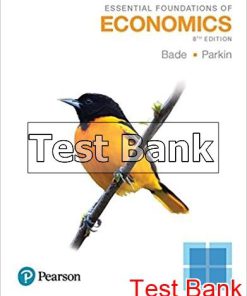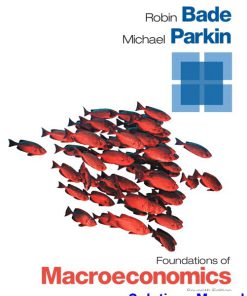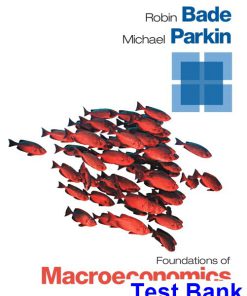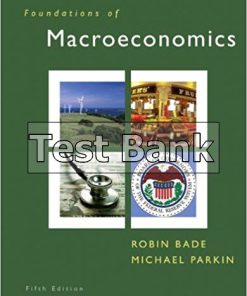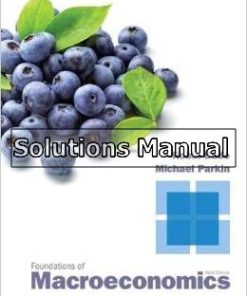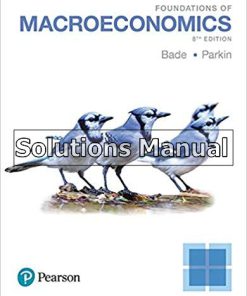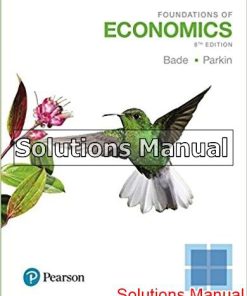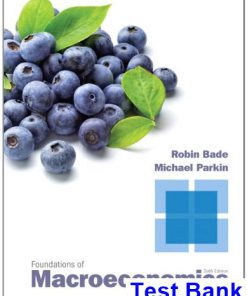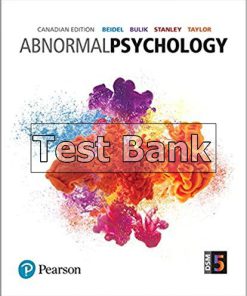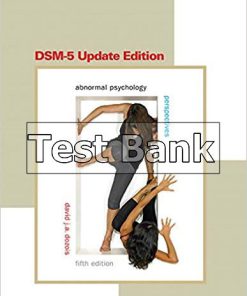Foundations of Macroeconomics 8th Edition Bade Test Bank
$50.00 Original price was: $50.00.$26.50Current price is: $26.50.
Foundations of Macroeconomics 8th Edition Bade Test Bank.
Foundations of Macroeconomics 8th Edition Bade Test Bank
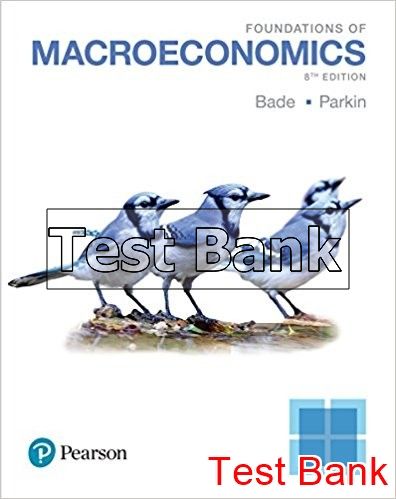
Product details:
- ISBN-10 : 0134492005
- ISBN-13 : 978-0134492001
- Author: Robin Bade
Foundations of Macroeconomics, 8th Edition introduces readers to the economic principles they can use to navigate the financial decisions of their futures. Each chapter concentrates on a manageable number of ideas, usually 3 to 4, with each reinforced several times throughout the text. This patient approach helps guide individuals through unfamiliar terrain and focus them on the most important concepts.
The text does four core things to help readers grasp and apply economic principles: it motivates with compelling issues and questions, focuses on core ideas, offers concise points, and encourages learning with activities and practice questions. After completing this text, readers will have the foundational knowledge of how the economy works and can apply it to their lives going forward.
Table contents:
- Part 1 Introduction
- Chapter 1 Getting Started
- Chapter Checklist
- 1.1 Definition and Questions
- Scarcity
- Economics Defined
- What, How, and For Whom?
- Can the Pursuit of Self-Interest Be in the Social Interest?
- Checkpoint 1.1
- 1.2 The Economic Way of Thinking
- A Choice Is a Tradeoff
- Cost: What You Must Give Up
- Benefit: What You Gain
- Rational Choice
- How Much? Choosing at the Margin
- Choices Respond to Incentives
- Checkpoint 1.2
- 1.3 Economics as a Life Skill
- Economics as a Decision Tool
- Economics as a Social Science
- Economics as an Aid to Critical Thinking
- Checkpoint 1.3
- Chapter Summary
- Chapter Checkpoint
- Appendix: Making and Using Graphs
- Basic Idea
- Interpreting Data Graphs
- Interpreting Graphs Used in Economic Models
- The Slope of a Relationship
- Relationships Among More Than Two Variables
- Appendix Checkpoint
- Eye on the Benefit and Cost of School Did You Make the Right Decision?
- Eye on Your Life Your Time Allocation
- Eye on the Past Adam Smith and the Birth of Economics as a Social Science
- Chapter 2 The U.S. and Global Economies
- Chapter Checklist
- 2.1 What, How, and for Whom?
- What Do We Produce?
- How Do We Produce?
- For Whom Do We Produce?
- Checkpoint 2.1
- 2.2 The Global Economy
- The People
- The Economies
- What in the Global Economy
- How in the Global Economy
- For Whom in the Global Economy
- Checkpoint 2.2
- 2.3 The Circular Flows
- Households and Firms
- Markets
- Real Flows and Money Flows
- Governments
- Governments in the Circular Flow
- Circular Flows in the Global Economy
- Checkpoint 2.3
- Chapter Summary
- Chapter Checkpoint
- Eye on the U.S. Economy What We Produce
- Eye on the Past Changes in What We Produce
- Eye on the U.S. Economy Changes in How We Produce in the Information Economy
- Eye on the Dreamliner Who Makes the Dreamliner?
- Eye on the Global Economy Differences in How We Produce
- Eye on Your Life The U.S. and Global Economies in Your Life
- Eye on the Past Growing Government
- Eye on the Global Economy The Ups and Downs in International Trade
- Chapter 3 The Economic Problem
- Chapter Checklist
- 3.1 Production Possibilities
- Production Possibilities Frontier
- How the PPF Illustrates Scarcity and Its Consequences
- Checkpoint 3.1
- 3.2 Opportunity Cost
- The Opportunity Cost of a Smartphone
- Opportunity Cost and the Slope of the PPF
- Opportunity Cost Is a Ratio
- Increasing Opportunity Costs Are Everywhere
- Your Increasing Opportunity Cost
- Checkpoint 3.2
- 3.3 Economic Growth
- Checkpoint 3.3
- 3.4 Specialization and Trade
- Absolute Advantage and Comparative Advantage
- Comparative Advantage: A Model
- Achieving Gains from Trade
- The Economy’s Production Possibilities Frontier
- Checkpoint 3.4
- Chapter Summary
- Chapter Checkpoint
- Eye on Your Life Your Production Possibilities Frontier
- Eye on the Environment Is Wind Power Free?
- Eye on the U.S. Economy Expanding Our Production Possibilities
- Eye on the Global Economy Hong Kong’s Rapid Economic Growth
- Eye on the U.S. Economy No One Knows How to Make a Pencil
- Eye on Your Life Your Comparative Advantage
- Chapter 4 Demand and Supply
- Chapter Checklist
- Competitive Markets
- 4.1 Demand
- The Law of Demand
- Demand Schedule and Demand Curve
- Changes in Demand
- Illustrating Changes in Buying Plans
- Checkpoint 4.1
- 4.2 Supply
- The Law of Supply
- Supply Schedule and Supply Curve
- Changes in Supply
- Illustrating a Change in Selling Plans
- Checkpoint 4.2
- 4.3 Market Equilibrium
- Price: A Market’s Automatic Regulator
- Predicting Price Changes: Three Questions
- Effects of Changes in Demand
- Effects of Changes in Supply
- Effects of Changes in Both Demand and Supply
- Checkpoint 4.3
- 4.4 Price Rigidities
- Price Floor
- Price Ceiling or Price Cap
- Sticky Price
- Checkpoint 4.4
- Chapter Summary
- Chapter Checkpoint
- Eye on Your Life Understanding and Using Demand and Supply
- Eye on the Global Economy The Markets for Cocoa and Chocolate
- Eye on the Price of Coffee Why Did the Price of Coffee Rise in 2014?
- Eye on the U.S. Economy The Federal Minimum Wage
- Part 2 Monitoring the Macroeconomy
- Chapter 5 GDP: A Measure of Total Production and Income
- Chapter Checklist
- 5.1 GDP, Income, and Expenditure
- GDP Defined
- Circular Flows in the U.S. Economy
- Expenditure Equals Income
- Checkpoint 5.1
- 5.2 Measuring U.S. GDP
- The Expenditure Approach
- The Income Approach
- GDP and Related Measures of Production and Income
- Real GDP and Nominal GDP
- Calculating Real GDP
- Using the Real GDP Numbers
- Checkpoint 5.2
- 5.3 The Uses and Limitations of Real GDP
- The Standard of Living Over Time
- Tracking the Course of the Business Cycle
- The Standard of Living Among Countries
- Goods and Services Omitted from GDP
- Other Influences on the Standard of Living
- Checkpoint 5.3
- Chapter Summary
- Chapter Checkpoint
- Appendix: Measuring Real GDP
- The Problem With Base Year Prices
- Value Production in the Prices of Adjacent Years
- Appendix Checkpoint
- Eye on the U.S. Economy Is a Computer Program an Intermediate Good or a Final Good?
- Eye on Booms and Busts How Do We Track Economic Booms and Busts?
- Eye on Your Life Making GDP Personal
- Eye on the Global Economy Which Country Has the Highest Standard of Living?
- Chapter 6 Jobs and Unemployment
- Chapter Checklist
- 6.1 Labor Market Indicators
- Current Population Survey
- Population Survey Criteria
- Three Labor Market Indicators
- Alternative Measures of Unemployment
- Checkpoint 6.1
- 6.2 Labor Market Trends and Fluctuations
- Unemployment Rate
- The Participation Rate
- Alternative Measures of Unemployment
- Checkpoint 6.2
- 6.3 Unemployment and Full Employment
- Frictional Unemployment
- Structural Unemployment
- Cyclical Unemployment
- “Natural” Unemployment
- Unemployment and Real GDP
- Checkpoint 6.3
- Chapter Summary
- Chapter Checkpoint
- Eye on the U.S. Economy The Current Population Survey
- Eye on the Global Economy Unemployment and Labor Force Participation
- Eye on the U.S. Economy How Long Does it Take to Find a Job?
- Eye on Full Employment Are We Back at Full Employment?
- Eye on Your Life Your Labor Market Status and Activity
- Chapter 7 The CPI and the Cost of Living
- Chapter Checklist
- 7.1 The Consumer Price Index
- Reading the CPI Numbers
- Constructing the CPI
- The CPI Market Basket
- The Monthly Price Survey
- Calculating the CPI
- Measuring Inflation and Deflation
- The Price Level, Inflation, and Deflation in the United States
- Checkpoint 7.1
- 7.2 The CPI and Other Price Level Measures
- Sources of Bias in the CPI
- The Magnitude of the Bias
- Two Consequences of the CPI Bias
- Alternative Consumer Price Indexes
- Checkpoint 7.2
- 7.3 Nominal and Real Values
- Dollars and Cents at Different Dates
- Nominal and Real Values in Macroeconomics
- Nominal GDP and Real GDP
- Nominal Wage Rate and Real Wage Rate
- Nominal Interest Rate and Real Interest Rate
- Checkpoint 7.3
- Chapter Summary
- Chapter Checkpoint
- Eye on the Past 700 Years of Inflation and Deflation
- Eye on the U.S. Economy Measuring and Forecasting Inflation: The Sticky-Price CPI
- Eye on the U.S. Economy Deflating the GDP Balloon
- Eye on the Past The Nominal and Real Wage Rates of Presidents of the United States
- Eye on Box Office Hits Which Movie Really Was the Biggest Box Office Hit?
- Eye on Your Life A Student’s CPI
- Part 3 The Real Economy
- Chapter 8 Potential GDP and the Natural Unemployment Rate
- Chapter Checklist
- Macroeconomic Approaches and Pathways
- The Three Main Schools of Thought
- Today’s Consensus
- The Road Ahead
- 8.1 Potential GDP
- The Production Function
- The Labor Market
- Checkpoint 8.1
- 8.2 The Natural Unemployment Rate
- Job Search
- Job Rationing
- Checkpoint 8.2
- Chapter Summary
- Chapter Checkpoint
- Eye on the U.S. Economy The Lucas Wedge and the Okun Gap
- Eye on the Global Economy Potential GDP in the United States and the European Union
- Eye on Potential GDP Why Do Americans Earn More and Produce More Than Europeans?
- Eye on the Past The Natural Unemployment Rate Over Seven Decades
- Eye on the Global Economy Unemployment Benefits and the Natural Unemployment Rate
- Eye on the U.S. Economy The Federal Minimum Wage
- Eye on Your Life Natural Unemployment
- Chapter 9 Economic Growth
- Chapter Checklist
- 9.1 The Basics of Economic Growth
- Calculating Growth Rates
- The Magic of Sustained Growth
- Checkpoint 9.1
- 9.2 Labor Productivity Growth
- Labor Productivity
- Saving and Investment in Physical Capital
- Expansion of Human Capital and Discovery of New Technologies
- Combined Influences Bring Labor Productivity Growth
- Checkpoint 9.2
- 9.3 Causes and Effects of Economic Growth
- Old Growth Theory
- New Growth Theory
- Economic Growth and the Distribution of Income
- Checkpoint 9.3
- 9.4 Achieving Faster Growth
- Preconditions for Economic Growth
- Policies to Achieve Faster Growth
- How Much Difference Can Policy Make?
- Checkpoint 9.4
- Chapter Summary
- Chapter Checkpoint
- Eye on the Past How Fast Has Real GDP per Person Grown?
- Eye on the U.S. Economy U.S. Growth Is Slowing
- Eye on the U.S. Economy U.S. Labor Productivity Growth Since 1960
- Eye on the U.S. Economy The Changing Shares in the Gains from Economic Growth
- Eye on Your Life How You Influence and Are Influenced by Economic Growth
- Eye on Rich and Poor Nations Why Are Some Nations Rich and Others Poor?
- Chapter 10 Finance, Saving, and Investment
- Chapter Checklist
- 10.1 Financial Institutions and Financial Markets
- Some Finance Definitions
- Markets for Financial Capital
- Financial Institutions
- Insolvency and Illiquidity
- Interest Rates and Asset Prices
- Checkpoint 10.1
- 10.2 The Loanable Funds Market
- Flows in the Loanable Funds Market
- The Demand for Loanable Funds
- The Supply of Loanable Funds
- Equilibrium in the Loanable Funds Market
- Changes in Demand and Supply
- Checkpoint 10.2
- 10.3 Government in Loanable Funds Market
- A Government Budget Surplus
- A Government Budget Deficit
- Checkpoint 10.3
- Chapter Summary
- Chapter Checkpoint
- Eye on the U.S. Economy Interest Rate Patterns
- Eye on the U.S. Economy The Loanable Funds Market in a Financial Crisis
- Eye on Your Life Your Participation in the Loanable Funds Market
- Eye on Financial Markets Why Have Interest Rates Been So Low?
- Part 4 The Money Economy
- Chapter 11 The Monetary System
- Chapter Checklist
- 11.1 What Is Money?
- Definition of Money
- The Functions of Money
- Money Today
- Official Measures of Money: M1 and M2
- Checks, Credit Cards, Debit Cards, and Mobile Wallets
- An Embryonic New Money: E-Cash
- Checkpoint 11.1
- 11.2 The Banking System
- Commercial Banks
- Thrift Institutions
- Money Market Funds
- Checkpoint 11.2
- 11.3 The Federal Reserve System
- The Structure of the Federal Reserve
- The Fed’s Policy Tools
- How the Fed’s Policy Tools Work
- Checkpoint 11.3
- 11.4 Regulating the Quantity of Money
- Creating Deposits by Making Loans
- How Open Market Operations Change the Monetary Base
- The Multiplier Effect of an Open Market Operation
- The Money Multiplier
- Checkpoint 11.4
- Chapter Summary
- Chapter Checkpoint
- Eye on the Past The “Invention” of Banking
- Eye on the U.S. Economy Commercial Banks Under Stress in the Financial Crisis
- Eye on Your Life Money and Your Role in Its Creation
- Eye on Creating Money How Does the Fed Create Money and Regulate Its Quantity?
- Chapter 12 Money, Interest, and Inflation
- Chapter Checklist
- Where We Are and Where We’re Heading
- The Real Economy
- The Money Economy
- Real and Money Interactions and Policy
- 12.1 Money and the Interest Rate
- The Demand for Money
- Changes in the Demand for Money
- The Supply of Money
- The Nominal Interest Rate
- Changing the Interest Rate
- Checkpoint 12.1
- 12.2 Money, the Price Level, and Inflation
- The Money Market in the Long Run
- A Change in the Quantity of Money
- The Price Level in a Baby-Sitting Club
- The Quantity Theory of Money
- Inflation and the Quantity Theory of Money
- Hyperinflation
- Checkpoint 12.2
- 12.3 The Cost of Inflation
- Tax Costs
- Shoe-Leather Costs
- Confusion Costs
- Uncertainty Costs
- How Big Is the Cost of Inflation?
- Checkpoint 12.3
- Chapter Summary
- Chapter Checkpoint
- Eye on the U.S. Economy Credit Cards and Money
- Eye on Your Life Money Holding and Fed Watching
- Eye on Inflation What Causes Inflation?
- Eye on the Past Hyperinflation in Germany in the 1920s
- Part 5 Economic Fluctuations
- Chapter 13 Aggregate Supply and Aggregate Demand
- Chapter Checklist
- 13.1 Aggregate Supply
- Aggregate Supply Basics
- Changes in Aggregate Supply
- Checkpoint 13.1
- 13.2 Aggregate Demand
- Aggregate Demand Basics
- Changes in Aggregate Demand
- The Aggregate Demand Multiplier
- Checkpoint 13.2
- 13.3 Explaining Economic Trends and Fluctuations
- Macroeconomic Equilibrium
- Three Types of Macroeconomic Equilibrium
- Economic Growth and Inflation Trends
- The Business Cycle
- Inflation Cycles
- Deflation and the Great Depression
- Checkpoint 13.3
- Chapter Summary
- Chapter Checkpoint
- Eye on the U.S. Economy U.S. Economic Growth, Inflation, and the Business Cycle
- Eye on Your Life Using the AS-AD Model
- Eye on the Business Cycle Why Did the U.S. Economy Go into Recession in 2008?
- Chapter 14 Aggregate Expenditure Multiplier
- Chapter Checklist
- 14.1 Expenditure Plans and Real GDP
- The Consumption Function
- Imports and Real GDP
- Checkpoint 14.1
- 14.2 Equilibrium Expenditure
- Induced Expenditure and Autonomous Expenditure
- Aggregate Planned Expenditure and Real GDP
- Equilibrium Expenditure
- Convergence to Equilibrium
- Checkpoint 14.2
- 14.3 Expenditure Multipliers
- The Basic Idea of the Multiplier
- The Size of the Multiplier
- The Multiplier and the MPC
- The Multiplier, Imports, and Income Taxes
- Business-Cycle Turning Points
- Checkpoint 14.3
- 14.4 The AD Curve and Equilibrium Expenditure
- Deriving the AD Curve from Equilibrium Expenditure
- Checkpoint 14.4
- Chapter Summary
- Chapter Checkpoint
- Eye on the U.S. Economy The U.S. Consumption Function
- Eye on the Past Say’s Law and Keynes’ Principle of Effective Demand
- Eye on Your Life Looking for Multipliers
- Eye on the Multiplier How Big Is the Government Expenditure Multiplier?
- Chapter 15 The Short-Run Policy Tradeoff
- Chapter Checklist
- 15.1 The Short-Run Phillips Curve
- Aggregate Supply and the Short-Run Phillips Curve
- Aggregate Demand Fluctuations
- Why Bother with the Phillips Curve?
- Checkpoint 15.1
- 15.2 Short-Run and Long-run Phillips Curves
- The Long-Run Phillips Curve
- Expected Inflation
- The Natural Rate Hypothesis
- Changes in the Natural Unemployment Rate
- Have Changes in the Natural Unemployment Rate Changed the Tradeoff?
- Checkpoint 15.2
- 15.3 Influencing Inflation and Unemployment
- Influencing the Expected Inflation Rate
- Targeting the Unemployment Rate
- Checkpoint 15.3
- Chapter Summary
- Chapter Checkpoint
- Eye on the Global Economy Inflation and Unemployment
- Eye on the Past The U.S. Phillips Curve
- Eye on the Past A Live Test of the Natural Rate Hypothesis
- Eye on the Tradeoff Can We Have Low Unemployment and Low Inflation?
- Eye on Your Life The Short-Run Tradeoff in Your Life
- Part 6 Macroeconomic Policy
- Chapter 16 Fiscal Policy
- Chapter Checklist
- 16.1 The Federal Budget
- The Institutions and Laws
- Budget Balance and Debt
- The Federal Budget in Fiscal 2017
- A Fiscal Policy Challenge
- Generational Accounting
- Checkpoint 16.1
- 16.2 Fiscal Stimulus
- Fiscal Policy and Aggregate Demand
- Automatic Fiscal Policy
- Cyclical and Structural Budget Balances
- Discretionary Fiscal Policy
- A Successful Fiscal Stimulus
- Limitations of Discretionary Fiscal Policy
- Checkpoint 16.2
- 16.3 The Supply Side: Potential GDP and Growth
- Full Employment and Potential GDP
- Fiscal Policy, Employment, and Potential GDP
- Fiscal Policy and Potential GDP: A Graphical Analysis
- Taxes, Deficits, and Economic Growth
- The Supply-Side Debate
- Long-Run Fiscal Policy Effects
- Checkpoint 16.3
- Chapter Summary
- Chapter Checkpoint
- Eye on the Global Economy The U.S. Budget in Global Perspective
- Eye on the Past Federal Tax Revenues, Outlays, Deficits, and Debt
- Eye on the U.S. Economy Fiscal and Generational Imbalances
- Eye on the U.S. Economy The U.S. Structural and Cyclical Budget Balances
- Eye on Fiscal Stimulus Can Fiscal Stimulus End a Recession?
- Eye on the Global Economy Some Real-World Tax Wedges
- Eye on Your Life Your Views on Fiscal Policy and How Fiscal Policy Affects You
- Chapter 17 Monetary Policy
- Chapter Checklist
- 17.1 How the Fed Conducts Monetary Policy
- Monetary Policy Objectives
- Operational “Maximum Employment” Goal
- Operational “Stable Prices” Goal
- Responsibility for Monetary Policy
- Policy Instrument
- Hitting the Federal Funds Rate Target
- Restoring Financial Stability in a Financial Crisis
- Checkpoint 17.1
- 17.2 Monetary Policy Transmission
- Quick Overview
- Interest Rate Changes
- Exchange Rate Changes
- Money and Bank Loans
- The Long-Term Real Interest Rate
- Expenditure Plans
- The Fed Fights Recession
- The Fed Fights Inflation
- Loose Links and Long and Variable Lags
- A Final Reality Check
- Checkpoint 17.2
- 17.3 Alternative Monetary Policy Strategies
- An Interest Rate Rule
- A Monetary Base Rule
- Inflation Targeting
- Money Targeting Rule
- Checkpoint 17.3
- Chapter Summary
- Chapter Checkpoint
- Eye on the Fed in a Crisis Did the Fed Save Us from Another Great Depression?
- Eye on the U.S. Economy The Fed’s Decisions Versus Two Rules
- Eye on the Global Economy Inflation Targeting Around the World
- Eye on Your Life Your Views on Monetary Policy and How Monetary Policy Affects You
- Chapter 18 International Trade Policy
- Chapter Checklist
- 18.1 How Global Markets Work
- International Trade Today
- What Drives International Trade?
- Why the United States Imports T-shirts
- Why the United States Exports Airplanes
- Winners, Losers, and Net Gains from Trade
- Checkpoint 18.1
- 18.2 International Trade Restrictions
- Tariffs
- Import Quotas
- Other Import Barriers
- Checkpoint 18.2
- 18.3 The Case Against Protection
- Three Traditional Arguments for Protection
- Four Newer Arguments for Protection
- Why Is International Trade Restricted?
- Checkpoint 18.3
- Chapter Summary
- Chapter Checkpoint
- Eye on the U.S. Economy U.S. Exports and Imports
- Eye on Globalization Who Wins and Who Loses from Globalization?
- Eye on the Past The History of U.S. Tariffs
- Eye on Your Life International Trade
- Chapter 19 International Finance
- Chapter Checklist
- 19.1 Financing International Trade
- Balance of Payments Accounts
- Borrowers and Lenders, Debtors and Creditors
- Current Account Balance
- Checkpoint 19.1
- 19.2 The Exchange Rate
- Demand in the Foreign Exchange Market
- The Law of Demand for Foreign Exchange
- Changes in the Demand for Dollars
- Supply in the Foreign Exchange Market
- The Law of Supply of Foreign Exchange
- Changes in the Supply of Dollars
- Market Equilibrium
- Exchange Rate Expectations
- Purchasing Power Parity
- Monetary Policy and the Exchange Rate
- Pegging the Exchange Rate
- The People’s Bank of China in the Foreign Exchange Market
- Checkpoint 19.2
- Chapter Summary
- Chapter Checkpoint
- Eye on the U.S. Economy The U.S. Balance of Payments
- Eye on the Global Economy Current Account Balances Around the World
- Eye on the Dollar Why Does Our Dollar Fluctuate?
- Eye on the Global Economy Purchasing Power Parity
- Eye on the Global Economy The Managed Yuan
- Eye on Your Life Your Foreign Exchange Transactions
- Glossary
- Index
- Credits
People also search:
foundations of macroeconomics 8th edition
principles of microeconomics 8th asia-pacific edition
principles of macroeconomics 8th edition answers
principles of macroeconomics 8th canadian edition answer key
principles of microeconomics 8th edition answers
Instant download after Payment is complete
You may also like…
Solutions Manual
Foundations of Macroeconomics 6th Edition Bade Solutions Manual
Solutions Manual
Foundations of Macroeconomics 8th Edition Bade Solutions Manual
Solutions Manual




